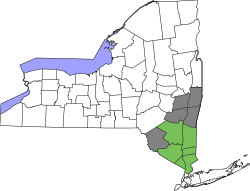
The Albany Plan of Union was a rejected plan to create a unified government for the Thirteen Colonies at the Albany Congress on July 10, 1754 in Albany, New York. The plan was suggested by Benjamin Franklin, then a senior leader (age 48) and a delegate from Pennsylvania. Based largely on his observations of the Iroquois and their system of common government, Franklin strongly urged fellow colonial leaders to consider the plan. More than twenty representatives of several Northern Atlantic colonies had gathered to plan their defense related to the French and Indian War (1754–1763), the front in North America of the Seven Years' War between Great Britain and France, spurred on by George Washington's recent defeat in the Ohio valley. [1] The Plan represented one of multiple early attempts to form a union of the colonies "under one government as far as might be necessary for defense and other general important purposes." The plan was rejected but it was a forerunner for the Articles of Confederation and the United States Constitution. [2]


